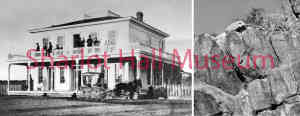By Stan Brown
This is part 1 of a 3-part historical backroad trip adventure from Prescott to Seligman. Wait until you have all 3 parts to make the trip come alive. In the meantime, pick up a Prescott National Forest map at 344 S. Cortez or at Granite Mountain Outfitters.
One of Yavapai County's many beautiful drives, and a good one for entertaining guests, is the Williamson Valley Road out of Prescott northward to Seligman. Not only is this a scenic drive, but these 70 miles have many stories to tell from Arizona's Territorial days.
We begin at mile zero, where the Williamson Valley Road takes off from Iron Springs at the fire station. On the Prescott National Forest map, Williamson Valley Road is Forest Service Road #6 and County Road #5. According to Will Barnes' "Arizona Place Names," it was named after Lt. Williamson of the 1858 Ives party.
 At mile 8.4, on our left, we pass the road to the American Ranch at the foot of the east side of Granite Mountain. Dan Connor, who had come with the Walker Party (and whose diary is our best record of the arrival of gold miners in 1863), staked this area as a homestead, calling it The American Ranch. When he decided to go to California, Connor traded his claim to Jefferson Harrison Lee for a gun he needed for his trip. Lee built a ranch house with an escape tunnel in the likely event of an Indian raid. The escape route was accessed through a hole in the floor of the house. He used it once when his house was burned by the Indians. Lee rebuilt and established a stage stop for travelers on the Hardyville Road, which passed here, connecting Prescott and the Colorado River. Martha Summerhayes refers to this stop in her book "Vanished Arizona."
At mile 8.4, on our left, we pass the road to the American Ranch at the foot of the east side of Granite Mountain. Dan Connor, who had come with the Walker Party (and whose diary is our best record of the arrival of gold miners in 1863), staked this area as a homestead, calling it The American Ranch. When he decided to go to California, Connor traded his claim to Jefferson Harrison Lee for a gun he needed for his trip. Lee built a ranch house with an escape tunnel in the likely event of an Indian raid. The escape route was accessed through a hole in the floor of the house. He used it once when his house was burned by the Indians. Lee rebuilt and established a stage stop for travelers on the Hardyville Road, which passed here, connecting Prescott and the Colorado River. Martha Summerhayes refers to this stop in her book "Vanished Arizona."
A few miles north of the American Ranch is Mint Springs. Its creek rises on the north side of Granite Mountain, and flows northwest through what came to be known as Mint Valley. The name Robert Stringfield is attached to several places in this vicinity. He and his family homesteaded here a few years after arriving in Prescott in 1875. Descendants of the Stringfields continued the ranch, and fourth-generation Ralph Stringfield was instrumental in the establishment of the Prescott Cowboy Camp Meeting, held not far from here. There was a Mint Valley School district, the first school being built in 1883 by the Stringfield family about a mile west of the "highway." This indicates that a number of ranch families had settled in the area quite early. Some rocks from the foundation are the only trace of that school today. In 1918, the school was superseded by the Granite Mountain School District.
At mile 13 is the now private Inscription Canyon development. In this area is Talking Rock, which contains a collection of prehistoric rock art. Talking Rock and its canyon were deeded to the Yavapai Indians. The inscriptions were probably made by the Patayan people, Yuman-speaking descendents of the archaic Hokan who traveled down the Pacific coast some 2,000 years ago, and then moved eastward into Arizona. Extensive ruins were left by these people along Walnut Creek.
At Mile 17, there is a railroad crossing. The Santa Fe Railroad was eager to have a connection from its main line at Seligman to Prescott, and then on to Phoenix. Two contending business groups consolidated in 1885 to form the Prescott and Arizona Central Railway Company. The line to Seligman was completed Dec. 31, 1886, but was plagued with problems. The engines proved too small to pull more than six cars, the roadbed was easily washed out and, since there was no turntable in Prescott, trains had to return to Seligman by backing up all the way! The enterprise was a disaster, and was replaced in 1891 by the Santa Fe, Prescott and Phoenix Railway. This line cut up through Chino Valley and joined with the Santa Fe at Ash Fork. By 1893, it was in operation and was soon dubbed the "Peavine" because of the way it wound around and clung to the mountains. It is a connection of this line our road crosses.
Next week: more interesting and historic sites along the Williamson Valley Road to Seligman.
Days Past articles are available at sharlothallmuseum.org/library&archives/history/dayspast. The public is encouraged to submit articles for Days Past consideration. Please contact Scott Anderson at 445-3122 for information.


